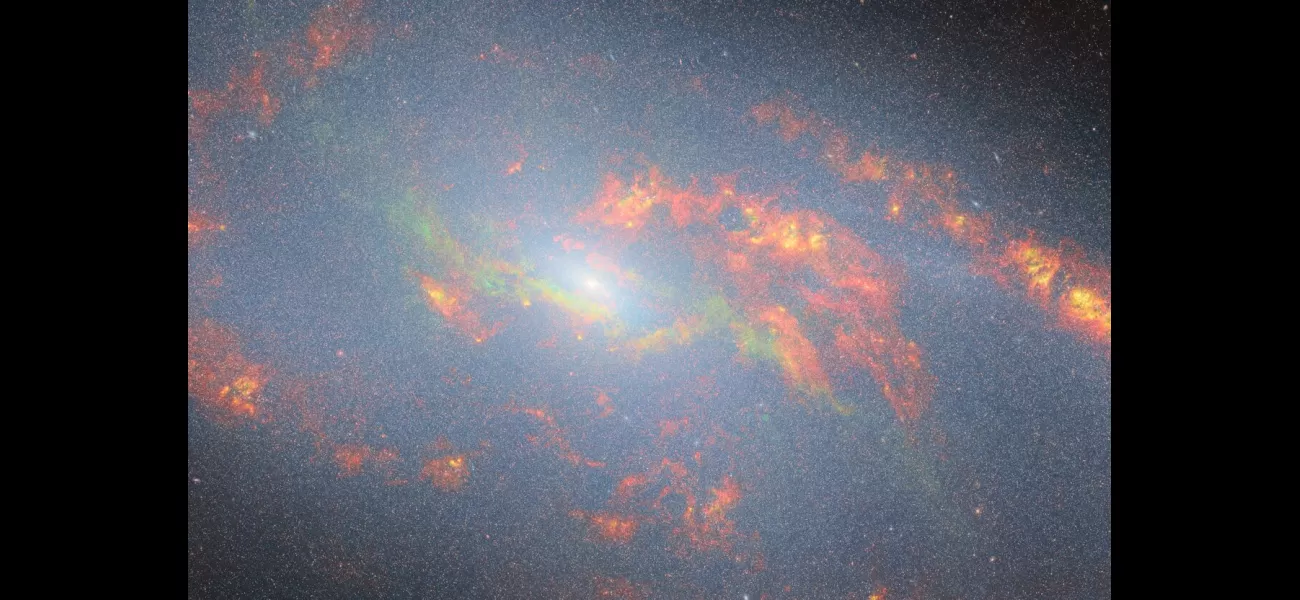Amazing photo of a black hole devouring its surroundings taken by James Webb telescope.
Scary yet beautiful.
August 12th 2024.

The James Webb Space Telescope has once again amazed us with its incredible capabilities, this time providing a detailed look at the black hole in Messier 106. Located in the spiral galaxy NGC 4258, which is about 23 million light-years away from our planet, this black hole is devouring any cosmic material that comes too close.
Despite being millions of light-years away, this black hole is considered to be relatively close to us in space terms. It is also known to be one of the brightest black holes in the universe, with two supernovae being detected within its galaxy in 1981 and 2014.
At the center of most spiral galaxies, including Messier 106, lies a supermassive black hole. However, this particular black hole is especially active, emitting powerful radiation as it feeds on surrounding gas. In comparison, the black hole at the center of our own galaxy, the Milky Way, is much calmer and only occasionally pulls in small amounts of gas.
Black holes are incredibly dense objects, with a massive amount of matter squeezed into a tiny space. The extreme gravity and curvature of spacetime near a black hole make it impossible for anything to escape once it gets too close.
Thanks to the James Webb Telescope's Near-InfraRed Camera, we now have a stunning new image of Messier 106's active galactic nucleus. The blue areas in the image represent the distribution of stars around the black hole, while the orange and red hues indicate the presence of dust at varying temperatures. Additionally, the green, yellow, and teal tones near the center of the image show the distribution of gas around the black hole.
Some interesting facts about black holes: The closest black hole to us is called Gaia BH1 and is located about 1,500 light-years away. Black holes can also spin incredibly fast, with the fastest known black hole, GRS 1915+105, rotating over 1,000 times per second. The lightest black hole known to us has a mass about 3.8 times that of our Sun. The first actual image of a black hole was released in 2019, captured by the Event Horizon Telescope and showing the black hole at the center of Messier 87. If our Sun were to be replaced by a black hole of the same mass, the planets would still orbit in the same way, but everything would be much colder.
One of the remarkable features of Messier 106 is the presence of two extra arms, visible in radio and X-ray wavelengths rather than visible light. These arms are believed to be a result of the black hole's activity, with material being expelled from the black hole and creating a wave-like effect.
Interestingly, the galaxy itself is named after the renowned astronomer Charles Messier, but it was actually discovered by his assistant Pierre Méchain. However, it was never catalogued by Messier himself and was only added to his catalogue after his death in the 20th century. Along with six other objects discovered by Messier and Méchain, Messier 106 was added to the catalogue posthumously.
In conclusion, the new image of Messier 106 captured by the James Webb Telescope has provided us with a closer look at a fascinating black hole, showcasing its powerful activity and its impact on its surrounding galaxy. These incredible images continue to deepen our understanding of the vast and mysterious universe we live in.
Despite being millions of light-years away, this black hole is considered to be relatively close to us in space terms. It is also known to be one of the brightest black holes in the universe, with two supernovae being detected within its galaxy in 1981 and 2014.
At the center of most spiral galaxies, including Messier 106, lies a supermassive black hole. However, this particular black hole is especially active, emitting powerful radiation as it feeds on surrounding gas. In comparison, the black hole at the center of our own galaxy, the Milky Way, is much calmer and only occasionally pulls in small amounts of gas.
Black holes are incredibly dense objects, with a massive amount of matter squeezed into a tiny space. The extreme gravity and curvature of spacetime near a black hole make it impossible for anything to escape once it gets too close.
Thanks to the James Webb Telescope's Near-InfraRed Camera, we now have a stunning new image of Messier 106's active galactic nucleus. The blue areas in the image represent the distribution of stars around the black hole, while the orange and red hues indicate the presence of dust at varying temperatures. Additionally, the green, yellow, and teal tones near the center of the image show the distribution of gas around the black hole.
Some interesting facts about black holes: The closest black hole to us is called Gaia BH1 and is located about 1,500 light-years away. Black holes can also spin incredibly fast, with the fastest known black hole, GRS 1915+105, rotating over 1,000 times per second. The lightest black hole known to us has a mass about 3.8 times that of our Sun. The first actual image of a black hole was released in 2019, captured by the Event Horizon Telescope and showing the black hole at the center of Messier 87. If our Sun were to be replaced by a black hole of the same mass, the planets would still orbit in the same way, but everything would be much colder.
One of the remarkable features of Messier 106 is the presence of two extra arms, visible in radio and X-ray wavelengths rather than visible light. These arms are believed to be a result of the black hole's activity, with material being expelled from the black hole and creating a wave-like effect.
Interestingly, the galaxy itself is named after the renowned astronomer Charles Messier, but it was actually discovered by his assistant Pierre Méchain. However, it was never catalogued by Messier himself and was only added to his catalogue after his death in the 20th century. Along with six other objects discovered by Messier and Méchain, Messier 106 was added to the catalogue posthumously.
In conclusion, the new image of Messier 106 captured by the James Webb Telescope has provided us with a closer look at a fascinating black hole, showcasing its powerful activity and its impact on its surrounding galaxy. These incredible images continue to deepen our understanding of the vast and mysterious universe we live in.
[This article has been trending online recently and has been generated with AI. Your feed is customized.]
[Generative AI is experimental.]
0
0
Submit Comment





